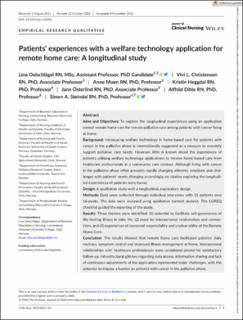| dc.contributor.author | Oelschlägel, Lina | |
| dc.contributor.author | Christensen, Vivi Lycke | |
| dc.contributor.author | Moen, Anne | |
| dc.contributor.author | Heggdal, Kristin | |
| dc.contributor.author | Österlind, Jane | |
| dc.contributor.author | Dihle, Alfhild | |
| dc.contributor.author | Steindal, Simen Alexander | |
| dc.date.accessioned | 2022-12-01T08:04:44Z | |
| dc.date.available | 2022-12-01T08:04:44Z | |
| dc.date.created | 2022-11-09T05:38:45Z | |
| dc.date.issued | 2022 | |
| dc.identifier.issn | 0962-1067 | |
| dc.identifier.uri | https://hdl.handle.net/11250/3035171 | |
| dc.description.abstract | To explore the longitudinal experiences using an application named remote home care for remote palliative care among patients with cancer living at home. Background: Introducing welfare technology in home-based care for patients with cancer in the palliative phase is internationally suggested as a measure to remotely support palliative care needs. However, little is known about the experiences of patients utilising welfare technology applications to receive home-based care from healthcare professionals in a community care context. Although living with cancer in the palliative phase often presents rapidly changing ailments, emotions and challenges with patients' needs changing accordingly, no studies exploring the longitudinal experiences of patients were found. Design: A qualitative study with a longitudinal, exploratory design. Methods: Data were collected through individual interviews with 11 patients over 16 weeks. The data were analysed using qualitative content analysis. The COREQ checklist guided the reporting of the study. Results: Three themes were identified: (1) potential to facilitate self-governance of life-limiting illness in daily life, (2) need for interpersonal relationships and connections, and (3) experiences of increased responsibility and unclear utility of the Remote Home Care. Conclusion: The results showed that remote home care facilitated patients' daily routines, symptom control and improved illness-management at home. Interpersonal relationships with healthcare professionals were considered pivotal for satisfactory follow-up. Infrastructural glitches regarding data access, information sharing and lack of continuous adjustments of the application represented major challenges, with the potential to impose a burden on patients with cancer in the palliative phase. | en_US |
| dc.language.iso | eng | en_US |
| dc.publisher | Wiley | en_US |
| dc.rights | Navngivelse 4.0 Internasjonal | * |
| dc.rights.uri | http://creativecommons.org/licenses/by/4.0/deed.no | * |
| dc.subject | eHealth | en_US |
| dc.subject | Cancer | en_US |
| dc.subject | Telemedicine | en_US |
| dc.subject | Person-centred care | en_US |
| dc.subject | Palliative care | en_US |
| dc.title | Patients experiences with a welfare technology application for remote home care: A longitudinal study | en_US |
| dc.type | Peer reviewed | en_US |
| dc.type | Journal article | en_US |
| dc.description.version | publishedVersion | en_US |
| cristin.ispublished | true | |
| cristin.fulltext | original | |
| cristin.qualitycode | 2 | |
| dc.identifier.doi | https://doi.org/10.1111/jocn.16592 | |
| dc.identifier.cristin | 2070892 | |
| dc.source.journal | Journal of Clinical Nursing (JCN) | en_US |

